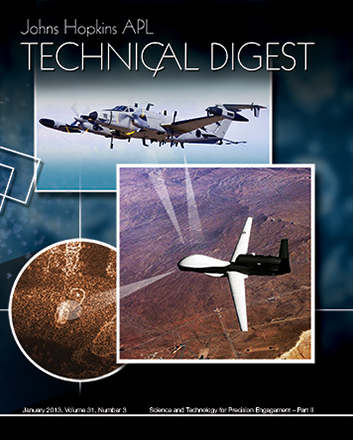
Science and Technology for Precision Engagement – Part II
Volume 31, Number 3 (2013)
This issue of the Johns Hopkins APL Technical Digest is the second of two issues devoted to science and technologies that are being pursued by APL's Precision Engagement Business Area. From developing models and simulations to better understand the environmental effects on aerodynamic stability of small unmanned aircraft in complex environments, to conducting field demonstrations of autonomous operation of unmanned systems, the Business Area has devoted considerable resources to improving operational performance in the realms of command, control, intelligence, surveillance, and reconnaissance (C2ISR) and engagement.
Science and Technology for Precision Engagement – Part II: Guest Editor's IntroductionSusan B. Kennedy |
Closed-Loop Collaborative Intelligence, Surveillance, and Reconnaissance Resource ManagementAndrew J. Newman and Jonathan T. DeSena |
Upstream Data Fusion: History, Technical Overview, and Applications to Critical ChallengesAndrew J. Newman and Glenn E. Mitzel |
Detection and Recognition of 3-D Targets in Panchromatic and in Synthetic Aperture Radar Imagery Using a Map-Seeking Circuit AlgorithmPatricia K. Murphy, Pedro A. Rodriguez, and Cameron K. Peterson |
Geo-Location Using Direction Finding AnglesMichael T. Grabbe and Brandon M. Hamschin |
High-Fidelity Antenna Pattern Modeling with Lidar CharacterizationJeffrey J. Dumm, Michael P. Boyle, and John P. Clancy |
MISCELLANEAAPL Achievement Awards and PrizesLinda L. Maier-Tyler |